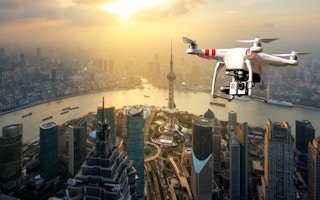The coronavirus pandemic sweeping across the planet will force city authorities and planners to more seriously consider factors such as population density, technology, food security and inadequate housing, urban experts said.
As of Wednesday morning the outbreak, termed Covid-19, had infected about 200,000 people worldwide and killed roughly 8,000, according to a global tally kept by Johns Hopkins University.
In response, countries have tightened border controls, imposed travel bans, locked down cities and stepped up surveillance using technology powered by artificial intelligence (AI).
“It is likely that Covid-19 will prompt a rethink of urban design and planning in the Asia-Pacific region,” said Tony Matthews, a senior lecturer in urban and environmental planning at Australia’s Griffith University.
“There will probably be consideration of desirable population density levels, a greater utilisation of apps and smart data to track health trends, and many cities will probably start to think about their food security more closely,” he said.
Countries including China, South Korea and Singapore are using robots, drones and big data to track the outbreak, disinfect hospitals and deliver supplies.
Such technologies may become a fixture in cities to flag potential problems for quicker response, said Matthews.
Authorities are also likely to more closely monitor vector-borne diseases such as dengue fever that are shifting due to climate change, and impose limits on the types and numbers of live animals in traditional markets, he said.
Coronaviruses are zoonotic diseases - meaning they are passed from animals to humans - and the rapid pace of deforestation and urbanisation are major factors in the spread of these diseases in Asia, health experts say.
Authorities in China said they would tighten supervision of traditional markets in the cities.
“
Historically, epidemics have acted as catalysts in transforming how diseases are handled, especially in urban areas.
Annie Wilkinson, research fellow, Institute of Development Studies
Catalysts
This would not be the first time that an epidemic has led to changes in city planning, research shows.
The cholera outbreaks of the 1830s led to better sanitation in London and elsewhere, while the tuberculosis epidemic in New York in the early 20th century paved the way for improved public transit systems and housing regulations.
The Severe Acute Respiratory Syndrome (SARS) outbreak in 2003, which hit cities such as Hong Kong and Singapore, led Singapore to upgrade its medical infrastructure and create systems to map the disease.
“Historically, epidemics have acted as catalysts in transforming how diseases are handled, especially in urban areas,” said Annie Wilkinson, a research fellow at the Institute of Development Studies, a UK-based think tank.
“Community engagement is key to effective epidemic control, be it delivering trusted messages, carrying out surveillance, or limiting movement,” she said.
In Singapore, which has among the fastest ageing populations in the world, engaging with older people was key as the coronavirus has a higher mortality rate among seniors.
Singapore’s ministry of health worked with community partners to ensure that essential services such as home-based care and transportation continued to reach seniors, a spokeswoman for the ministry said.
More than 500 volunteers aim to visit about 27,000 seniors to keep them updated on the outbreak and address concerns, she said. Other service providers delivered meals and offered counselling.
Such decentralisation of services may become more common in cities, said Creighton Connolly, a senior lecturer at the University of Lincoln in England.
“Decentralisation of services and reducing density are ways to combat disease spread, though this is contrary to sustainable transport and climate-change related goals,” he said.
“Also, very dense cities like Hong Kong and Singapore have contained the virus better than largely rural areas like Lombardy and Veneto in Italy. Ultimately, governance dimensions are more important than planning or design approaches,” he said.
Food security
More than two-thirds of the global population is forecast to live in urban areas by 2050 - up from 56 per cent today, according to the United Nations.
With cities battling worsening climate-change effects, planners also have to balance competing demands for land.
China hurriedly built 16 makeshift hospitals in Wuhan, the city at the centre of the coronavirus epidemic, to handle the load.
In Hong Kong, some public housing blocks were requisitioned for quarantine facilities, while in Italy authorities in Genoa are converting a ferry to a hospital boat.
“Planners may consider leaving small parcels of strategic urban land available, in case temporary medical facilities or housing need to be set up,” said Matthews.
Alongside, authorities will also need to consider the issue of food security amidst lockdowns and closed borders, he said.
“Food security is a huge issue because cities don’t tend to produce their food,” he said.
Singapore, which imports more than 90 per cent of its food, is encouraging more local production, for example.
Some cities may create stockpiles, while others may try to produce more food locally through urban farming or through intensive growing facilities using hydroponics, Matthews said.
“But the bottom line is most cities rely on global supply lines for food and are therefore vulnerable to disruptions.”
Perhaps more importantly, planners will have to consider the impact of widening wealth inequality, with millions of homeless people and those living in slums at greater risk of contracting disease, said Wilkinson.
“Achieving longer-term changes in urban planning will depend on improving the way we see, understand and address health and living conditions in informal settlements,” she said.
“For many people living on the margins, crisis is already the norm and change is overdue.”
This story was published with permission from Thomson Reuters Foundation, the charitable arm of Thomson Reuters, that covers humanitarian news, climate change, resilience, women’s rights, trafficking and property rights. Visit http://news.trust.org/climate.












